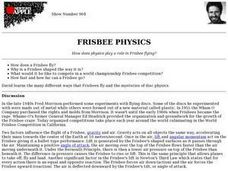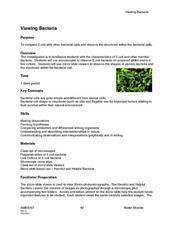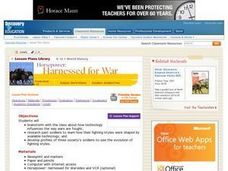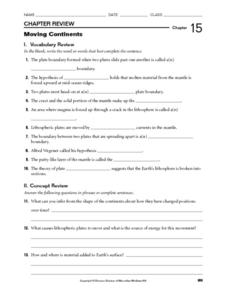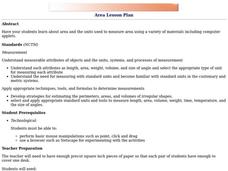Curated OER
Frisbee Physics
Students explain how a Frisbee flies, why it's shaped he way it is and how fast and how far the Frisbee can go.
Curated OER
Dynamic Collages and Assemblages
Students create a two, three, or four-dimensional collage or assemblage. They use shapes, colors, images, objects, and textures to create their collage.
Curated OER
A Dreamer's Cloak
Students listen to the teacher read "A Dreamer's Cloak." They examine the difference between squares and circles and create their own cloak by using a paper bag and different shapes.
Curated OER
Viewing Bateria
High schoolers use microscopes to observe E. coli bacateria on prepared slides and in a live culture. They use micro-slide viewers to observe the shapes of various bacteria and the structures within the bacterial cell. Students make an...
Curated OER
Yeast - A Dihybrid Cross
Learners make a yeast dihybrid cross and follow two forms of each of two traits: red growth versus cream color, and tryptophan-dependent versus tryptophan-independent.
Curated OER
Teaching the Bell Tetrahedral Kite
Students complete readings on kite making and kite flying. They analyze how the parts of a system interconnect and influence each other. Students identifies and uses color and form in a 3D artwork.
Curated OER
Harnessed for War
Students research past soldiers to learn how their fighting styles were shaped by available technology. They develop profiles of three different societies' soldiers in three different periods to see the evolution of fighting styles.
Curated OER
Moving Continents
In this moving continents worksheet, students review the different types of plate boundaries, what causes earthquakes, and where volcanoes are formed. This worksheet has 10 fill in the blank and 9 short answer questions.
Curated OER
Geoboard Ideas
Learners build polygons on their geoboards. For this geometry lesson plan, students build and then draw it on paper and label it. Learners then switch with a partner to try an make a symmetrical shape.
Curated OER
Observations and Inferences
Students observe how to distinguish observations form inferences. In this examining inferences instructional activity students list observations relating to the activity and discuss the importance of them.
Curated OER
Fall finger tree
In this fall tree worksheet, students cut and paste the leaf and apple shapes onto a tree made from their fingers. Students have 6 shapes to cut out.
Curated OER
Properties of Logarithms
Students explore the concept of logarithms. In this logarithms instructional activity, students graph logarithms on their Ti-Nspire calculator. Students describe the shapes of their graphs by identifying slope, y-intercepts,...
Curated OER
Area Lesson Plan
Students explore geometry by using computer applications. In this spatial measurement lesson, students discuss the difference between area, weight, volume and other forms of measurement. Students utilize computer applications to find the...
Curated OER
Lines of Symmetry
Fifth graders explore the concept of symmetry using lines drawn through different shapes. The worksheet that is included in the lesson should be used to chart the lines of symmetry for the different shapes drawn.
Curated OER
Bathymetry
Learners study the topography of the ocean floor and the geological processes of how it is formed. They summarize what bathymetry, describe how islands are formed and illustrate a bathymetric model of the sea floor.
Curated OER
Pasta Triangles - A Triangle Inequality Activity
Students explore, examine and experiment with pasta sticks to discover the triangle inequality principle. They assess if any three lines or segments fit together to form a triangle. Each student also completes a Triangle Recording Chart...
Starfall
Xx is in Six
In this printing activity, students form the upper and lowercase letter Xx. Students also color in a picture of an ox pulling a wagon.
Starfall
Xx is in Six
In this language arts worksheet, students learn to print both upper and lower case letter Xx. Students trace several examples before forming their own letters in the unlined boxes.
Curated OER
Origami
Students, through active participation in Japanese origami, demonstrate their skills in this cultural art form and develop an appreciation for other cultures.
Curated OER
VISUAL ARTS
Students learn the historical context of mask-making explore the elements of the art form.
Curated OER
Why Do We Add The Bases To Find The Area of A Trapezoid?
Middle schoolers are given patterns of trapezoids and are to calculate the area of one trapezoid by using both patterns. They should form a parallelogram and calculate the area. They practice this technique until there is understanding.
Curated OER
Landforms of Illinois
Young scholars discover the primary landforms of Illinois. They examine how those landforms were formed as well. In groups, they research one of the landforms from their vocabulary list. They create their landform in a shoebox and...
Curated OER
Linear Sculpture
Students discuss how artists communicate visually in their work using the elements of design. The elements of design should be used as the building blocks of the structure you are trying to create. The elements of design are form, space,...
Curated OER
Solids, Liquids, and Gases
Pupils explore the three main forms of matter: solid, liquid, and gas. They examine concrete examples of each, using their five senses and "experimenting" to find differences in them. They find pictures of each, cut them out and past...
Other popular searches
- Geometric Formulas
- Solving Geometric Formulas
- Art Shape and Form
- Use Geometric Formulas
- Art and Music Shape and Form
- Design Element, Shape and Form
